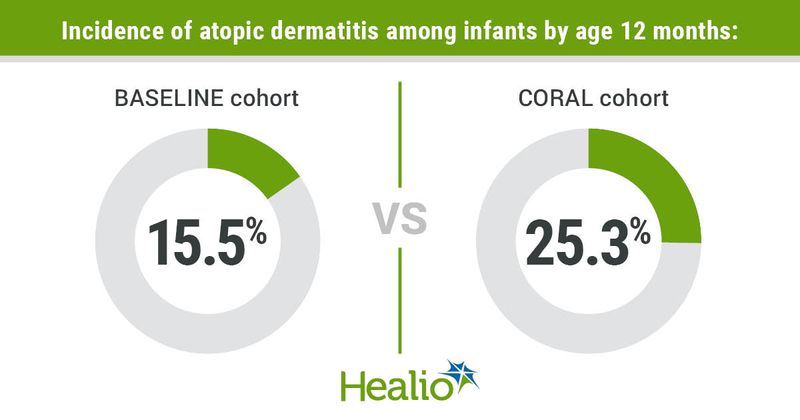Infants born during COVID-19 lockdown show higher rates of atopic dermatitis
Infants born during the COVID-19 lockdown in Ireland between March and May 2020 experienced higher rates of atopic dermatitis and egg sensitization, but not egg allergy, according to a study published in Pediatric Allergy and Immunology.
Researchers also found lower rates of infant illness and hospitalization as well as higher rates of breastfeeding in this population compared with historical datasets.

Data were derived from Hurley S, et al. Pediatr Allergy Immunol. 2022;doi:10.1111/pai.13766.
Sadhbh Hurley, MB, of Children’s Health Ireland and the department of pediatrics and child health at Royal College of Surgeons in Ireland, and colleagues examined data from 344 infants (55% boys; 96% white) born between March and May 2020 included in the CORAL birth cohort, a project that examines allergic and autoimmune dysregulation among infants bord during that time.
During a 12-month appointment, these infants received skin prick testing for milk, egg and peanut, an atopic dermatitis (AD) assessment and lateral flow SARS-CoV-2 antibody testing. Researchers also analyzed stool and blood samples.
Whereas 15.5% of infants in the 2008 BASELINE pre-pandemic cohort had AD by age 12 months, 25.3% (n = 87) of the CORAL infants had AD (P < .0001). Also, 74 of these 87 infants had active AD at the 12-month appointment, including 56 (76%) with mild, 15 (20%) with moderate and three (4%) with severe AD.
The BASELINE and CORAL cohorts had similar sensitization and allergy rates for milk and peanut, but the BASELINE cohort had lower rates of egg sensitization (3.7% vs. 5.8%; P = .02) and allergy (2.7% vs. 3.2%).
This significantly higher incidence of egg sensitization in the CORAL cohort may be due to its higher incidence of AD, according to the researchers. However, they acknowledged that the fact that this did not translate to higher incidence of egg allergy may be due to changes in clinical practice pertaining to the graded reintroduction of baked egg in infants who have a history of reaction to egg, leading to tolerance in most cases.
Also, the researchers noted 2015 figures indicating that 58% of babies born in Ireland were receiving breastmilk upon discharge from the hospital after birth, falling to 35% at 3 months, 15% at 6 months and 11% at 9 months. But in the CORAL cohort, 54% of infants at 6 months and 35% at 12 months were still receiving breast milk.
At 12 months, 66% of the mothers in the CORAL cohort had returned to work, including working from home, when their infants were aged 2 to 12 months (mean age, 9.1 months).
Yet 29% of mothers who had returned to work in the CORAL group were still breastfeeding at 12 months, which the researchers called “dramatically higher” than pre-pandemic figures, attributing this increase to mothers working from home and the convenience, access or privacy they enjoyed.
Additionally, less than half of the infants in the CORAL cohort had experienced any infective illness by 12 months, with 17% receiving a systemic antibiotic. Figures from 2008, though, reported 90% of infants experiencing an illness before age 12 months, with 80% receiving a systemic antibiotic.
Considering potential changes in the microbiome due to social distancing during the lockdown, as well as less antibiotic use and greater breastfeeding rates, the researchers said they will continue to analyze their data from the 6- and 12-month appointments for further explanations for the increases in egg sensitization and AD.
